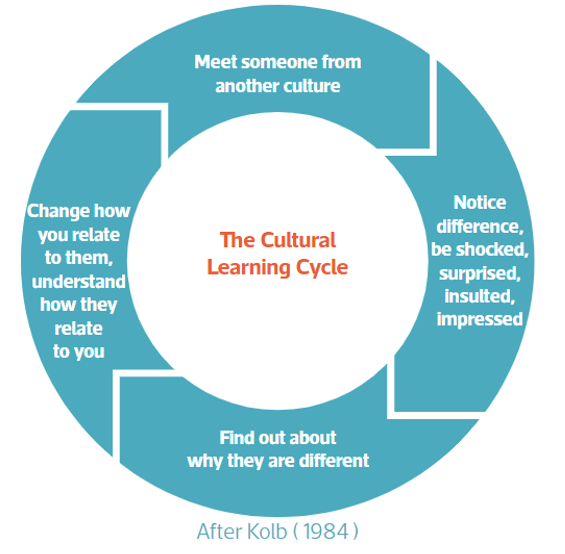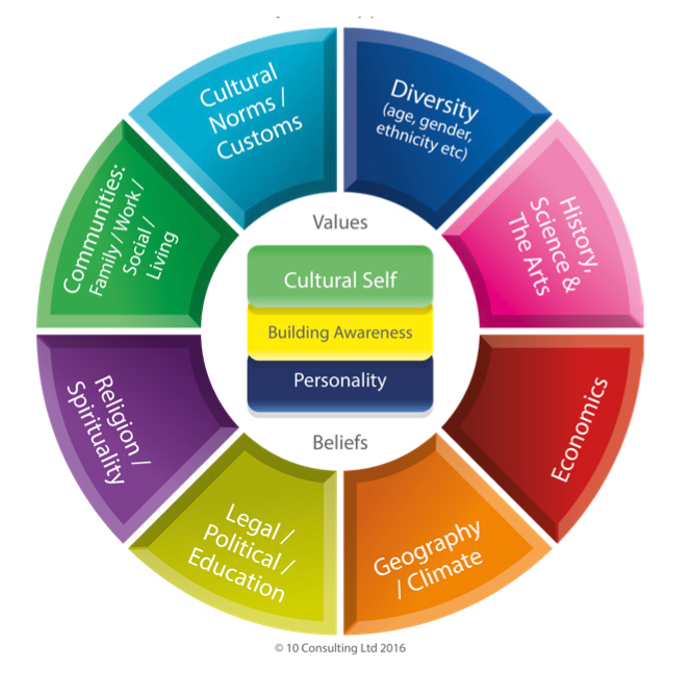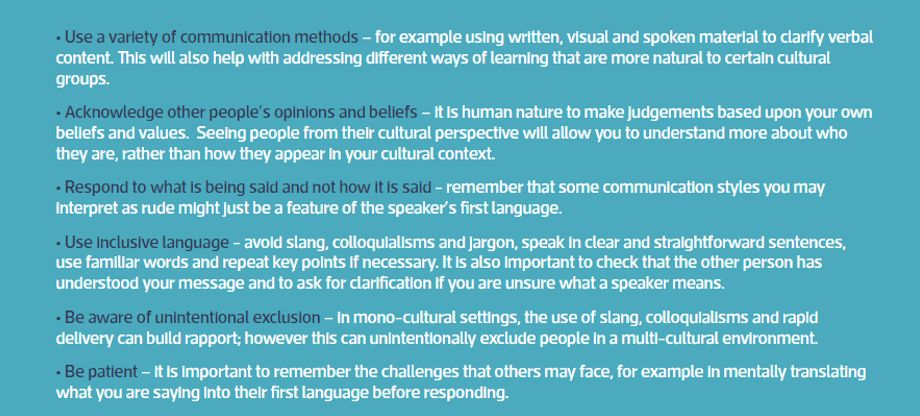What do we mean by culture?
National culture has specific characteristics such as language, religion, ethnic and racial identity, and cultural history and traditions.
National culture influences family life, education, economic and political structures, and, of course, how we run our organisations. Deal and Kennedy ( 1982 ) defined organisational culture as the way things get done around here. Schein ( 1992 ) included artefacts, values and tacit assumptions in culture highlighting that the values that are spoken about sometimes conflict with the unspoken assumptions. Although differences between ethnic and religious cultures may be most pronounced, organisations vary greatly in their cultures and an understanding of cultural difference offers insight into why organisations can be so different and how culture affects everything.
The Cultural Learning Cycle
We can use Kolb’s learning cycle to think about cultural difference and what to do when we meet people from different cultures. Knowing that there are likely to be differences in how we view the world is a good starting point, we should notice differences as different, not better or worse and then find out more about the particular culture. Charles Hampden-Turner and Fons Trompenaars ( 1994 ) identified seven different dimensions of culture including how different cultures approach the law and their attitude to time. Such insights enable us to understand the difference and adjust our responses accordingly.

Cross-Cultural Management
Everyone brings their own values, beliefs and assumptions to a cross-cultural environment and the way in which you interact with others can reveal more than you expect about your background. This can make cross-cultural interaction challenging and if you don’t manage this effectively, it can create barriers and lead to the formation of prejudices.
Barriers to cross-cultural collaboration include:

Barriers and conflict might also arise as a result of social status, religious beliefs and personal appearance.
The Cross-Cultural Kaleidoscope A Systems Approach
The Cross-Cultural Kaleidoscope is a coaching tool to explore and assess the significance of eight cultural dimensions
on an individual's values and beliefs that are culturally constructed.

Different Nations’ Structural Preferences
France: Autocratic. To outsiders, the CEO may, on first glance, appear to have a roving, consultative role. But when the facts are in and decisions made, the orders are top-down.
Sweden:Primus inter pares. A generally democratic structure, with the bare minimum of layers. The CEO is a central pivot between different functions, and is highly accessible.
United States: Structured individualism. Upper and middle managers are tasked with significant responsibilities, and often prize their own welfare above that of the wider firm.
Germany: Hierarchy and consensus. A clear and rigorous chain of command is complemented with a genuine desire to convince and win round staff in different departments.
Japan: Ringi-sei consensus. Senior executives have an aura of power, but little hands-on involvement. Ideas for new initiatives are often collected from various layers of a firm’s personnel, and then filtered up to the top for ratification.
Cultural Differences in the Workplace

References
Earley, C. & Mosakowski, E. (2004). Cultural Intelligence Harvard Business Review Kolb, D.A. (1984). Experiential learning: experience as the source of learning and development. Englewood Cliffs, NJ: Prentice HallLewis R (2005). When Cultures Collide: Leading Across Cultures Hodder & Stoughton General DivisionPlaister-Ten, J. (2016). The Cross-Cultural Coaching Kaleidoscope Book Club, page 84 Pratt-Johnson, Y. (2006). Communicating Cross-Culturally: What Teachers Should Know The Internet TESL Journal, Vol. 12, No. 2Trompenaars, A. & Hamden-Turner C. (1994). Riding the waves of culture: understanding diversity in global business
Do you respect different cultures? Test yourself with our Scorecard.
If you’re a member, you can test yourself on Respecting Different Cultures and see if you meet the standard.
Spotlights
Further Resources
From the Blog







